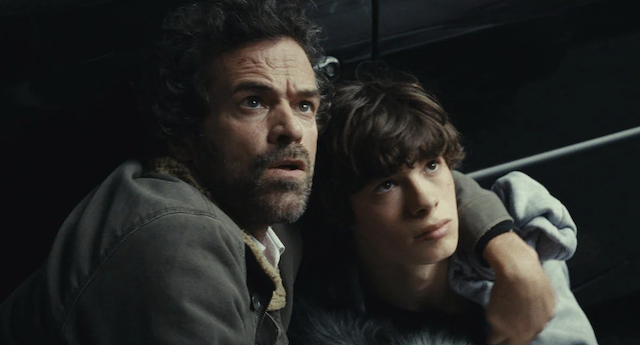
©Magnet Releasing
In THE ANIMAL KINGDOM, a visionary new thriller that drops viewers into an extraordinary world where mutations in human genetics cause people to transform into hybrid creatures, François (Roman Duris) does everything he can to save his wife, who is affected by this mysterious condition. As some of the creatures disappear into a nearby forest, François embarks with Emile (Paul Kircher), their 16-year-old son, on a quest to find her with help from a local police officer (Adèle Exarchopoulos).
Genre: Adventure, Drama, Sci-fi
Original Language: French
Director: Thomas Cailley
Producer: Pierre Guyard
Writer: Thomas Cailley, Pauline Munier
Release Date (Theaters): Limited
Release Date (Streaming):
Runtime:
Distributor: Magnet Releasing

©Magnet Releasing
Exclusive Interview with Co-Writer/Director Thomas Cailley
Q : You wrote the screenplay with Pauline Munier. How did this come about? Were there any inspirations from books or films?
Thomas Cailley: It’s an original story but my co-screenwriter Pauline and I talked about an American graphic novel that we both loved called “Black Hole” by Charles Burns. We also talked about Bong Joon-Ho’s film “The Host,” particularly regarding the mix of fantasy and realism in the story and the characters’ lives. We also thought about Sidney Lumet’s film, “Running on Empty,” which is a film that’s very important to me in how it treats the matter of the relationship between a father and son.
Q: What’s engaging about this film is that it shows the process of a mutation, of changing into an animal. Emile slowly couldn’t ride a bike or had a strong reaction as the animal emerged, as in the laboratory, its power growing stronger, like in a tug of war. How did you develop the process of them mutating, changing into animals?
Thomas: We wanted the mutation process to be realistic and not magical. So we showed a slow progressive transformation that, in a sense, is more like a disease. We decided that whenever a character gained an animal characteristic, that character would lose a human characteristic.
So when Emile starts to run fast, he loses coordination and can no longer ride a bike. When Felix learns to fly, he can no longer speak. It’s by combining these animal and human attributes, that we avoided making them into superheroes. If they had just been gaining all these things, they would be superheroes; I did not want to make a superhero movie. I wanted my movie to remain at the level of these characters.
Q: Talk about working with the makeup team. How did you transform the bad guys such as Fix and Emile, with nails and teeth and all that. How did you collaborate with the makeup team to show such fantastic transformations?
Thomas Cailley: The field of makeup and prosthetics is one that I really didn’t know but discovered it with this film. In doing so, I discovered that there are incredibly gifted craftspeople, really artists in France working in this field, who don’t get to exercise their talents much on French movies because in France we don’t make many movies with creatures.
They primarily work in Anglo-Saxon productions. But the great thing about makeup is that it really sticks to the actor’s skin. It helps the actor enter his or her role. it also reacts well with the actor’s body, to the muscles and skin. In making the film, we knew that we would be using a lot of tight shots because what I was really interested in was the relationship between characters and them accepting their differences.
Makeup was really the thing that would allow us to get closest to the mutations. There were different levels of makeup for different characters, different constraints. For instance, Emile had three or four hours of makeup put on each day, whereas with Fix, who’s the bird man, he had seven hours a day of make-up time.
Q: Talk about the process of casting Paul Kircher and filming with Romain Duris and Adèle Exarchopoulos. It’s not an easy task for him to act with them.
Thomas: I saw about 200 young people while looking for the person to play Emile, and Paul was the one who immediately convinced me. I found him so moving. I liked everything about him. There’s something fantastic about him, which is that he has this tremendous power, but he’s not conscious of it. In certain scenes, you see it come out, there’s something nearly wild about him, something explosive.
He got along very well with Romain Duris, which was really essential because the film is so much about a father/son relationship. It was tremendously important that from the first second that we were filming them together, we were looking at a dad and his son. It had to be clear that we weren’t looking at these two actors playing the roles.
Q: You have a strong message about the evolution of human beings, but also the preservation of animals in the future. It’s subtle in this film, but also obvious that with the evolution of human beings, we need the preservation of animals.
Thomas: The main message of the film, at least, is centered around the question of how we cohabitate. First, between humans, learning to deal with each other’s differences, and then with what’s beyond human or outside humanity, how to reinvent our environment in a way that retrains us from pillaging and destroying, so as to live in harmony with nature.
The creatures are a metaphor. We humans are the only species who have set up a frontier or border between humanity and all other living beings. What’s interesting about this film was to blur that border so that we feel we belong to a larger world.
Check out more of Nobuhiro’s articles.
Here’s the trailer of the film.

